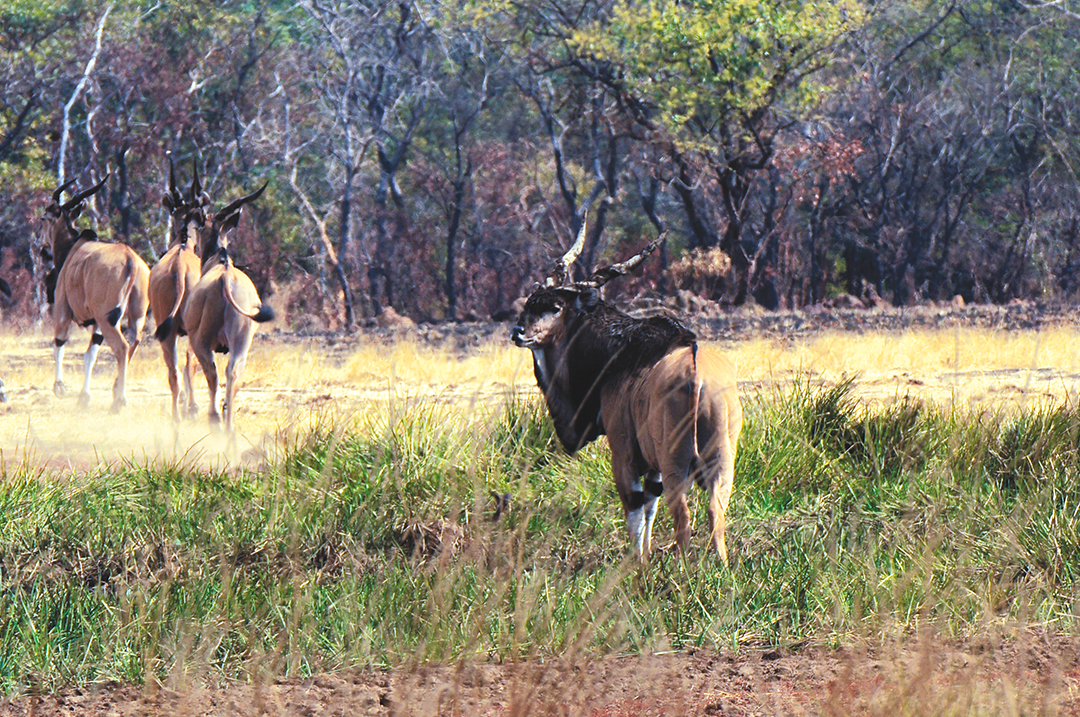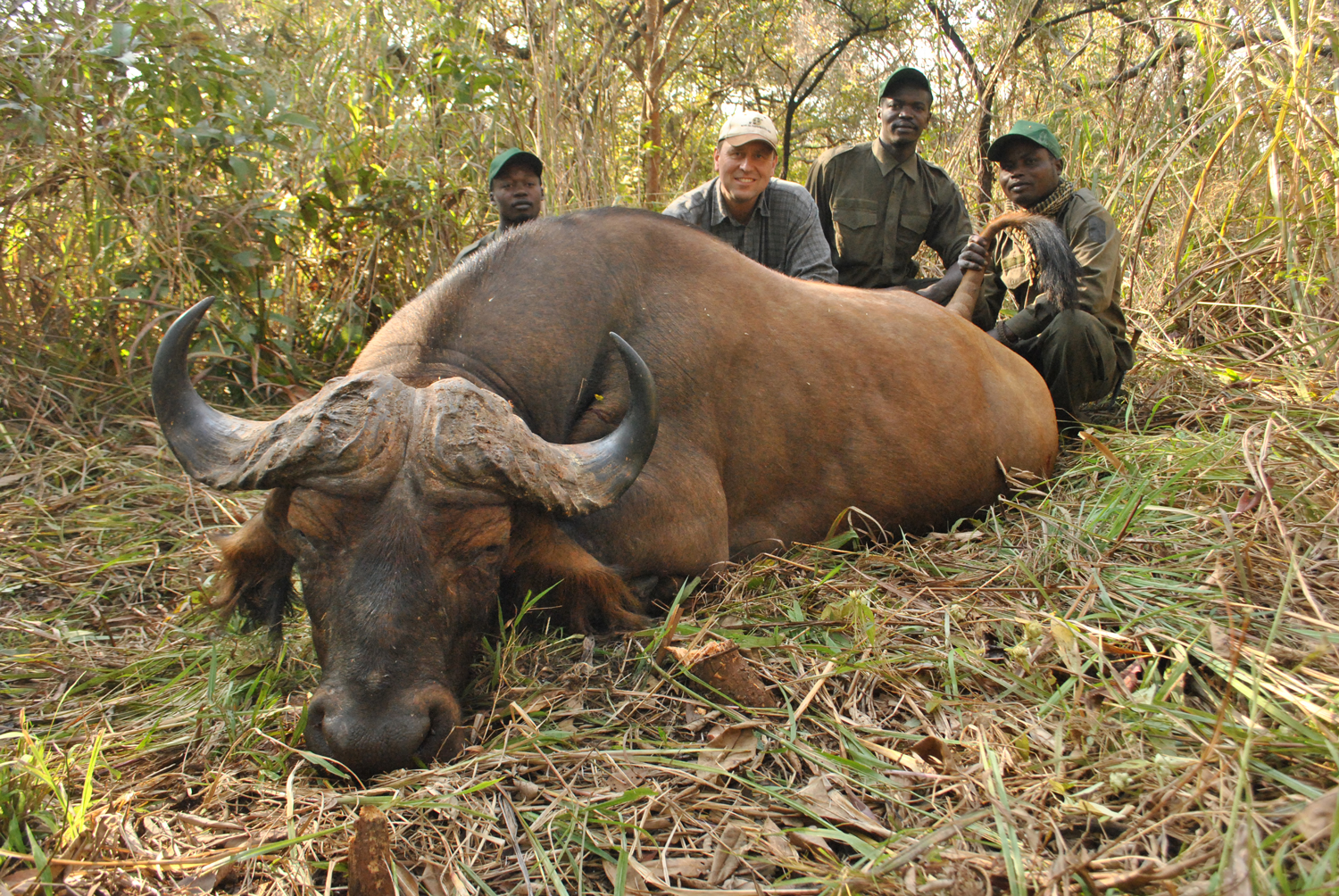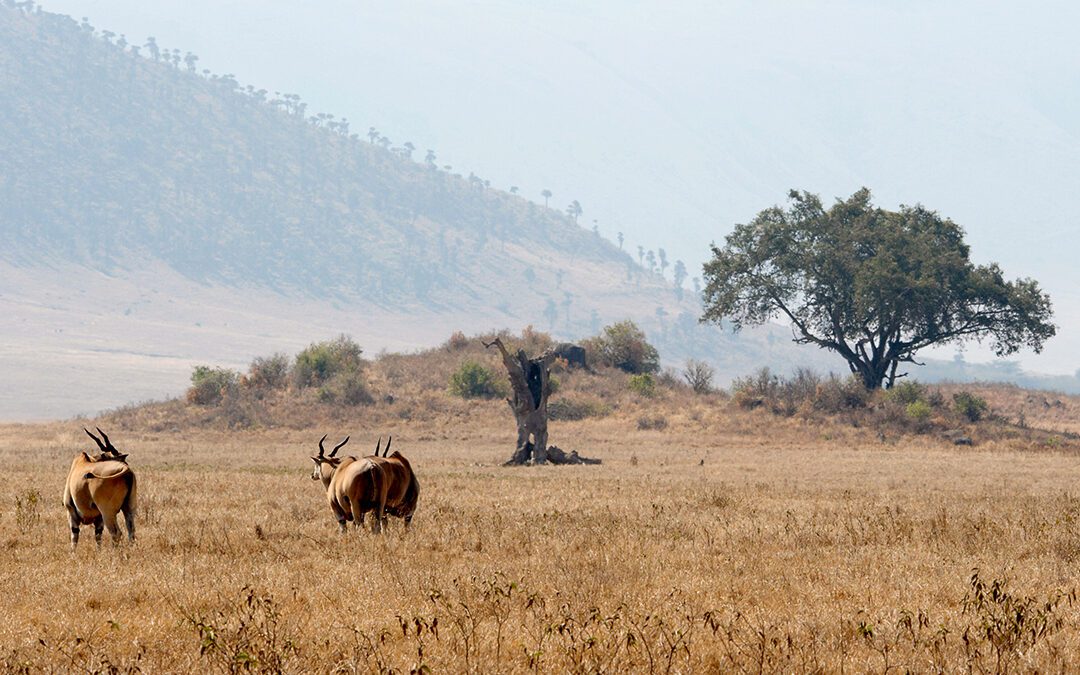Most African safaris have become somewhat leisurely activities in which hunting from vehicles is the primary method of locating wild game. But there are still a few animals that can be pursued only in the kind of primitive, harsh environments typical of ancient Africa, and with the same methods employed by early hunters and explorers.
Indeed, hunting for the magnificent Lord Derby’s eland has changed little, if at all, over the past century. To bag the king of antelopes, the keen hunter best lace up his boots, pack a full bag of food and water, and strike out into the sub-Saharan bush on foot.
Over my many years of guiding hunters in the far reaches of the Central African Republic, I have come to appreciate the Lord Derby’s eland as the king of the ungulate world. He is big and formidable, yet graceful and surprisingly elusive. Weighing upwards of 1,500 pounds, a mature bull stands six feet at the shoulder, and during the rut his neck is too thick for the largest man to wrap his arms around. With his large, piercing eyes, he can spot trouble from amazing distances and with his big ears, pick up the quietest footfalls of a stalking hunter.
Several years ago, during a full week of hunting in the eastern CAR with Norwegian sportsman Henrik Jensen, we had failed to find a fresh eland track. We finally happened upon the fresh tracks of an old bull near a salt lick, and with high anticipation we set out to follow it. We hoped to catch him in his midday resting place.

Mopani flies are a constant annoyance in eland country.
For six hours the bull led us on a wild ride through flat grassland and thick mopani woodlands, and finally into the long grass on a high plateau, but he always stayed just out of sight. Once he moved into the tall grass, we knew our pursuit had ended. We simply could not track as fast as he walked, so we reluctantly abandoned our hunt for the day.
Hunters can be gluttons for punishment. When we found the same bull’s tracks, huge and enticing, on the same salt lick a few days later, we couldn’t resist following him again. The bull was kinder this time, taking us on a gentle course through shady woods and into a cool forest. But an “easy” eland day can be as difficult as the hardest hunting anywhere else, so after three hours of walking we sat down to catch our breath and grab some food and water.
After maybe an hour a whistle roused me from a nap, and I found my three trackers, Gambou, Samson, and Allen, squatting in front of me, eager to get on the track again. They had found the eland’s spoor on the other side of the forest, in an area with better soil for tracking. Their enthusiasm was contagious, and we followed the bull with renewed encouragement.

Bull eland shattered these trees in a display of dominance during mating season, typically in January and February.
After a mile or so our solitary bull track turned into a mess of prints from many eland, including young bulls, cows, and calves. The bull had slipped into the herd in late morning, and we were right behind them. In early January, right before the rut, solitary bulls will often hook up with a herd, waiting for the cows to come into heat. Eland bulls are not particularly aggressive, and will often tolerate several other males in the herd.
No matter how resilient you might be, after tracking all day under the oppressive African sun, with blisters forming on the tender parts of your feet, you’re eventually prone to letting down your guard. You might begin walking too fast, talking too loud, or failing to watch the bush out front. This is exactly what happened to us about 30 minutes before dark. We were tracking rather casually, and when I looked up, there, 50 yards in front of us, I saw the eland herd feeding along, blissfully unaware of us.
Henrik and I crept forward behind a clump of trees, leaving the trackers behind. After ten minutes or so the cool evening wind shifted toward the animals and the entire herd pounded away, our eight hours of tracking ruined in a split second. Once again darkness set in before we could walk the two miles back to my truck.

A veteran of many elephant hunts, Henrik knew the tracking game well, so when we decided to pick up the herd’s trail the next day, he wasn’t at all discouraged. Under normal conditions, if you see eland one day, you’ll usually find them again the following day. But not this time. The herd had marched into the most rocky, mountainous region in the area. Despite the superior tracking skills of our native helpers, we simply could not stay on a fresh track long enough to catch up with the animals.
Frustrated, we left the eland herd in the mountains and headed back to the truck more than four miles way. We were all distraught and in bad spirits, especially me. I was ahead of the group, pausing to let them catch up, when I looked up and saw a different herd of eland feeding our way. I dropped to the ground, examining the ten or so animals while waiting for Henrik to catch up.

A big Lord Derby’s bull follows his harem out of a mud wallow.
Now, here was the moment that defined Henrik as an experienced hunter—and an ethical one at that. One bull, completely unaware of our presence, grazed only 20 yards away. I told Henrik he could shoot the bull, but he looked at the animal and noted that he didn’t have the luxurious black coat typical of older bulls. With no further thought or regret, Henrik politely declined to shoot. He was firmly set on taking an old bull, even with only two days left of hunting.
After some time a mature female discovered us and spooked the entire herd. We headed back to camp, but this time exhilarated by our close encounter. More importantly, Henrik had earned the satisfaction that he could have justifiably taken a Lord Derby’s bull, but would rather go home empty-handed than take an animal he wasn’t completely satisfied with. I had immense respect for the man after that.
As an intermission to our eland hunting, we had a rare opportunity to hunt a lone savanna buffalo. This subspecies of African buffalo is similar to its Cape cousin in that some have wide, splayed-out horns, while others have short, sharply curled headware. Some savanna buffalo are black, but the bull we encountered was greyish-red with large horns. We spotted him just before dark on the edge of a dense forest. Henrik put a bullet from his .458 Lott square into his shoulder at 50 yards. We were confident in the shot, and noted a goodly amount of blood, but with darkness coming on fast we decided to take up the trail in the morning.
Our follow-up turned into a tense morning that began when we found the blood trail ending after 300 yards. Now we had a wounded buffalo on our hands in the thickest bush imaginable—a worst-case scenario.

Norwegian hunter Henrik Jensen with a savanna buffalo.
It took us an hour to walk 300 more yards. The tension ended abruptly when we saw the bull rise from his bed. Henrik’s snapshot into the bull’s hip, then another through the shoulders, knocked the buffalo down, and we all breathed a sigh of relief. His first bullet had barely penetrated the thick skin and muscle, and only scraped the lung, though the wound would have eventually killed the animal.
On our next-to-last day we happened upon another herd of eland, but this time we had the satisfaction of following a line of soft, green droppings from early morning to late afternoon. But strange things often happen in the African bush. Just when we expected to come upon the resting animals we heard the thundering sound of a military helicopter swooping overhead.
The Ugandan military helicopter was ferrying supplies to troops stationed a few hundred miles away in the town of Obo. The soldiers were searching out members of the Lord’s Resistance Army, an infamous rebel group that had been backed into its last stronghold along the border of South Sudan.
Of all the possible scenarios that could take place in the African bush, on this random day, when we were finally close to the animals of our quest, a helicopter had roared in and ruined everything.

We followed the eland until dark, when their tracks led into a stand of tall grass. We looked in disappointment at the dense wall of vegetation as we had found their beds mere moments before. They had lied down next to a patch of burning grass, waited until the fires had died down in the evening, and then crossed the burn and out of our grasp. For years I was convinced that animals were frightened by bush fires, but this herd wasn’t the least bit concerned.
We began our two-hour trek back to the car in the darkness, never to see another eland for the rest of the safari.
Thoroughly disheartened, I retired to the dining area the last night where I joined Henrik for some beer-drinking consolation. Alone next to a fire pit, while other hunters happily reveled in their success, Henrik and I talked quietly about the last few days. The liquor worked magic on our exhausted thoughts and we began talking in sentimental tones. The hunting had been hard, but grand. For two weeks we had pursued the elusive animals as persistently as any hunter could—and it still hadn’t been enough.

In a lingering moment of silence, a smile stretched across Henrik’s face and his eyes began to glisten. The whole two weeks of our journey flashed across his mind, and I saw, clearly, that he was content—even without a trophy to hang on the wall.
“Sometimes,” he said gazing up into the nighttime sky to gather his thoughts and then looking straight into my eyes, “It’s those hunts when you are least successful that you remember the most.”
A true hunter if I ever met one, Henrik left the next day with no trophy eland, but with the promise to return next season to pick up where we left off.

Epilogue: The irony of fate revealed itself on my very next safari, when my client, a man new to eland hunting, killed a massive Lord Derby’s bull on the very first day of his safari. Sweating next to his trophy after a seven-hour tracking job, he stated in bewilderment, “Well, if this is how eland hunting typically is, I would have called it quits after day one.”
And so it goes in central Africa, in pursuit of the holy grail.

